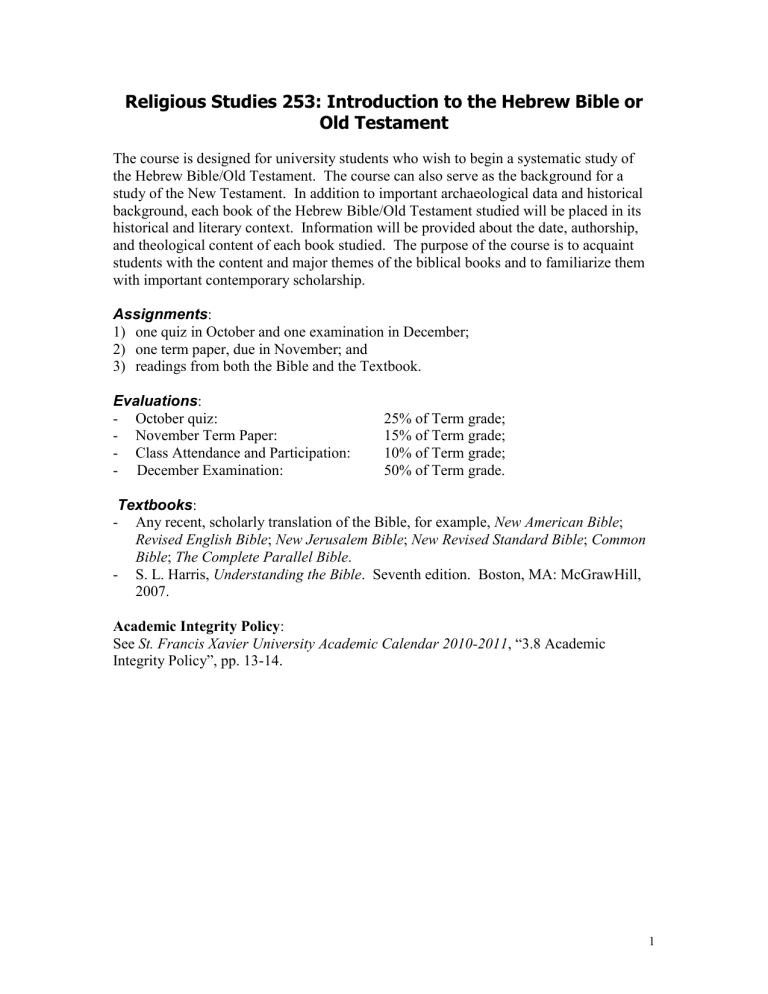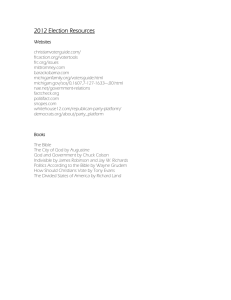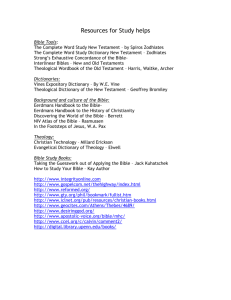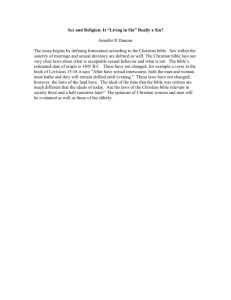RELS253.HebrewBibleOldTestament.2010.doc

Religious Studies 253: Introduction to the Hebrew Bible or
Old Testament
The course is designed for university students who wish to begin a systematic study of the Hebrew Bible/Old Testament. The course can also serve as the background for a study of the New Testament. In addition to important archaeological data and historical background, each book of the Hebrew Bible/Old Testament studied will be placed in its historical and literary context. Information will be provided about the date, authorship, and theological content of each book studied. The purpose of the course is to acquaint students with the content and major themes of the biblical books and to familiarize them with important contemporary scholarship.
Assignments :
1) one quiz in October and one examination in December;
2) one term paper, due in November; and
3) readings from both the Bible and the Textbook.
-
-
Evaluations :
October quiz:
November Term Paper:
25% of Term grade;
15% of Term grade;
Class Attendance and Participation: 10% of Term grade;
- December Examination: 50% of Term grade.
Textbooks :
Any recent, scholarly translation of the Bible, for example, New American Bible ;
Revised English Bible ; New Jerusalem Bible ; New Revised Standard Bible ; Common
Bible ; The Complete Parallel Bible .
S. L. Harris, Understanding the Bible . Seventh edition. Boston, MA: McGrawHill,
2007.
Academic Integrity Policy :
See St. Francis Xavier University Academic Calendar 2010-2011 , “3.8 Academic
Integrity Policy”, pp. 13-14.
1
Religious Studies 253: Introduction to the Hebrew Bible or
Old Testament
Tentative Outline
Introduction
1.
Questions People Frequently Ask about the Bible:
The Biblical God and the Covenant People;
Bible Writers, Manuscripts, and Translations;
The Canon of the Hebrew Bible/Old Testament;
Ways of Studying the Bible.
The Hebrew Bible: Tanak or Old Testament
2.
The History and Geography of the Near East (in outline form only):
The Ancient Near East;
The Promised Land;
Approaching the Bible.
3.
The Torah (Divine Instruction)/Pentateuch (Five Scrolls):
A Summary of the Torah/Pentateuch Story;
The Documentary Hypothesis;
Major Themes in the Torah/Pentateuch;
Some Literary Forms in the Torah/Pentateuch;
Genesis; Exodus; Leviticus; Numbers; Deuteronomy.
4.
The Prophets ( Nevi’im ) I: The Deuteronomistic History:
The Deuteronomists’ Theory of History;
Major Events and Their Meaning;
Joshua; Judges; 1 Samuel; 2 Samuel; 1 Kings; 2 Kings.
5.
The Prophets ( Nevi’im ) II: Collections Attributed to Individual Prophets:
Spokespersons for God;
The Three Great Crisis;
Order of the Prophets’ Appearances;
Amos; Hosea; Isaiah; Micah; etc.
6.
The Writings ( Kethuvim ): Books of Poetry, Wisdom, Short Fiction, and Sacred History:
After the Exile: A Reinterpretation of Judah’s Religious Mission;
Hebrew Poetry; Psalms; Wisdom Literature; Proverbs; Job; Festival Scrolls;
Reinterpreting Israel’s History for the Postexilic World: - - 1 Chronicles; 2 Chronicles;
Ezra; Nehemiah.
7.
Deuterocanonical and Apocalyptic Works:
The Covenant People in the Hellenistic World:
1 Maccabees; 2 Maccabees; Apocalyptic Literature and the Book of Daniel; Other
Deuterocanonical Writings (Books of the Apocrypha): Tobit; Judith; Baruch;
Ecclesiasticus; Wisdom of Solomon; additions to Daniel and Esther.
2
8.
Between the Two Testaments: Hellenistic Culture and the Growth of Multiple Judaisms:
Political Events;
The Diverse World of First-Century Judaisms;
Epilogue
9. The Evolution of the Hebrew Bible and the Christian-Greek Scriptures
.
Tentative Schedule of Events for Fall Term 2010 :
September 9 Fall Term Classes begin
October 11
October 21
November 11
November 18
December 7
December 9
December ?
December 18
Thanksgiving Day, no classes
Quiz
Remembrance Day, no classes
Fall Term Papers due
Last day of classes for Fall Term
Term examinations begin
Final Examination in this course
Christmas recess begins after last examination.
Recommended Readings On :
The Torah/Pentateuch:
J. Blenkinsopp, Introduction to the Pentateuch. Pp. 305-18 in The New Interpreter’s
Bible , Vol. 1. Nashville, Tenn.: Abingdon, 1994.
J.
Blenkinsopp, The Pentateuch: An Introduction to the First Five Books of the Bible .
New York: Doubleday, 1992.
E. Fox, ed. The Five Books of Moses . The Schocken Bible, Vol. 1. New York:
Schocken Books, 1995.
R. E. Friedman, Torah (Pentateuch). Pp. 605-622 in The Anchor Bible Dictionary , Vol.
6, ed. D. N. Freedman. New York: Doubleday, 1992.
R. E. Friedman, Who Wrote the Bible?
New York and San Francisco: Harper & Row,
1987.
3
A.
W. Jenks, Elohist. Pp 478-82 in The Anchor Bible Dictionary , Vol. 2, ed. D. N.
Freedman. New York: Doubleday, 1992.
J. Milgrom, Priestly (P) Source. Pp 454-61 in The Anchor Bible Dictionary , Vol. 5, ed.
D. N. Freedman. New York: Doubleday, 1992.
A.
de Pury, Yahwist. Pp. 1013-20 in The Anchor Bible Dictionary , Vol. 6, ed. D. N.
Freedman. New York: Doubleday, 1992.
R. Rendtorff, The Problem of the Process of Transmission of the Pentateuch . Sheffield,
UK: JSOT Press, 1990.
The Prophets ( Nevi’im ) I:
T.
E. Fretheim, Deuteronomic History . Nashville, Tenn.: Abingdon Press, 1983.
R. E. Friedman, Who Wrote the Bible?
New York and San Francisco: Harper & Row,
1987.
S. L. McKenzie, Deuteronomistic History. Pp. 160-68 in The Anchor Bible Dictionary ,
Vol. 2, ed. D. N. Freedman. New York: Doubleday, 1992.
The Prophets (
Nevi’im
) II:
J. Barton, Prophecy (Postexilic Hebrew). Pp. 489-95 in The Anchor Bible Dictionary ,
Vol. 5, ed. D. N. Freedman. New York: Doubleday, 1992.
A.
J. Heschel, The Prophets . New York: Harper & Row, 1963.
H. B. Huffmon, Prophecy (Ancient Near Eastern). Pp. 477-82 in The Anchor Bible
Dictionary , Vol. 2, ed. D. N. Freedman. New York: Doubleday, 1992.
J. Ward, Thus Says the Lord: The Message of the Prophets . Nashville, Tenn.: Abingdon
Press, 1991.
The Writings (Kethuvim):
R. Alter, The Art of Biblical Poetry . New York: Basic Books, 1985.
A.
Berlin, Introduction to Hebrew Poetry. Pp. 301-15 in
The New Interpreter’s Bible
,
Vol. 3. Nashville, Tenn.: Abingdon, 1994.
The Deuterocanonical and Apocalyptic Works :
N. de Lange, Apocrypha: Jewish Literature of the Hellenistic Age . New York: Viking
Press, 1978.
G. W. E. Nickelsburg, Jewish Literature Between the Bible and the Mishnah .
Philadelphia: Fortress Press, 1981.
M. Stone, Scriptures, Sects and Visions: A Profile of Judaism from Exra to the Jewish
Revolts . Philadelphia: Fortress Press, 1980.
4
Nota Bene : In addition to the above, The Angus L. MacDonald Library has excellent commentaries on all the books of the Hebrew Bible or Old Testament. Moreover, the library has many other books that introduce the student to the Hebrew Bible/Old
Testament as well as to different aspects of its thought.
Office Hours :
Monday: 9:30-11:00 a.m.
Thursday: 11:00 a.m.-12:30 p.m.
Office: Room 268 The Coady International Institute Building, Lower Campus (East
Wing)
Telephone: 902-867-2155 bmacdona@stfx.ca
http://www.stfx.ca/people/bmacdona/welcome.html
Burton MacDonald, PhD
September 2010
5









